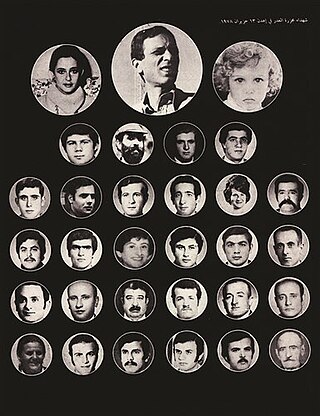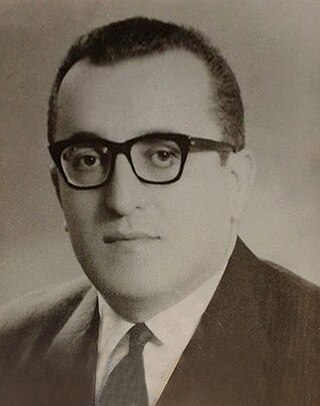
The Kataeb Party, officially the Kataeb Party – Lebanese Social Democratic Party, also known as the Phalangist Party, is a right-wing Christian political party in Lebanon founded by Pierre Gemayel in 1936. The party and its paramilitary wings played a major role in the Lebanese Civil War (1975–1990), opposing Palestinian insurgency in South Lebanon as well as collaborating with Israel. During the 1982 war, Phalangist militiamen committed the infamous Sabra and Shatilla massacre with support from the IDF. The Phalangists were also responsible for the Black Saturday massacre, the Tel al-Zaatar massacre, Ehden massacre, and the Karantina massacre, some of the worst massacres committed during the Lebanese Civil War. In 1982, Pierre's youngest son Bachir, the leader of the party's militia, was elected President, but was assassinated before he could take office. He was succeeded by his older brother Amine, who led the party through much of the war. In decline in the late 1980s and 1990s, the party slowly re-emerged in the early 2000s and is currently part of the Lebanese opposition. The party currently holds 4 out of the 128 seats in the Lebanese Parliament.

The Lebanese Civil War was a multifaceted armed conflict that took place from 1975 to 1990. It resulted in an estimated 150,000 fatalities and led to the exodus of almost one million people from Lebanon.

Amine Pierre Gemayel is a Lebanese politician who served as the 8th president of Lebanon from 1982 to 1988.
The Taif Agreement, officially known as the National Reconciliation Accord, was reached to provide "the basis for the ending of the civil war and the return to political normalcy in Lebanon". Negotiated in Taif, Saudi Arabia, it was designed to end the 15 year-long Lebanese Civil War, and reassert the Lebanese government's authority in southern Lebanon, which was controlled at the time by the Christian-separatist South Lebanon Army under the occupational hegemony of Israel. Though the agreement set a time frame for withdrawal of Syrian military forces from Lebanon, stipulating that the Syrian occupation end within two years, Syria did not withdraw its forces from the country until 2005. It was signed on 22 October 1989 and ratified by the Lebanese parliament on 5 November, 1989.

Samir Farid Geagea is a Lebanese politician and former militia commander who has been the leader of the Lebanese Forces political party and former militia since 1986.
The Hundred Days War was a subconflict within the 1977–82 phase of the Lebanese Civil War which occurred in the Lebanese capital Beirut. It was fought between the allied Christian Lebanese Front militias, under the command of the Kataeb Party's President Bachir Gemayel, and the Syrian troops of the Arab Deterrent Force (ADF).

The Marada Movement is a Lebanese political party and a former militia active during the Lebanese Civil War named after the legendary Marada warriors of the early Middle Ages that fought on the external edge of the Byzantine Empire. Originally designated the Marada Brigade, the group initially emerged as the personal militia of Suleiman Frangieh, president of Lebanon at the outbreak of the war in 1975, which also had a Parliamentary wing known as the Frangieh Bloc. They were also initially known as the Zgharta Liberation Army, after Frangieh's hometown of Zgharta in northern Lebanon.

The Lebanese Forces is a Lebanese Christian-based political party and former militia during the Lebanese Civil War. It currently holds 19 of the 128 seats in Lebanon's parliament, being the largest party of the country.
Karim Pakradouni is a Lebanese attorney and politician of Armenian origin. He was influential in Kataeb Party, heading it for some period. He was also influential in the Lebanese Forces in various critical phases of the LF. He was also minister of state in Rafic Hariri's government in 2004.
The War of Liberation was a sub-conflict within the final phase of the Lebanese Civil War between 1989 and 1990, in which the Lebanese Army loyal to General and Prime Minister Michel Aoun, appointed by previous President Amine Gemayel and headquartered in eastern Beirut, fought against the western Beirut-based Syrian Armed Forces and the Lebanese Army loyal to President Elias Hrawi and Prime Minister Salim Al-Huss, appointed by the Taif Agreement. Aoun launched several offensives against the Lebanese Forces in an attempt to establish his authority over East Beirut. The conflict culminated on 13 October 1990, when the Syrian Army stormed Baabda Palace and other strongholds of Aoun, killing hundreds of Lebanese soldiers and civilians and ousting Aoun, marking the end of the Lebanese Civil War. Aoun survived and moved to France to live in exile.

Fouad Abou Nader is a Lebanese Christian politician and former leader of the Lebanese Forces. A grandson of the Kataeb Party founder Pierre Gemayel, Abou Nader became a Kataeb party activist and head of the elite Kataeb troop called the "BG" and later on head of the Lebanese Forces after the union of various Christian military groupings. After an internal revolt in the Lebanese Forces led by Elie Hobeika and Samir Geagea against his leadership, he relinquished his power to them, refusing to fight in what he considered a fratricide venture.

Bachir Pierre Gemayel was a Lebanese militia commander who led the Lebanese Forces, the military wing of the Kataeb Party, in the Lebanese Civil War and was elected President of Lebanon in 1982.
The Zgharta Liberation Army – ZLA, also known as Zghartawi Liberation Army, was the paramilitary branch of the Lebanese Marada Movement during the Lebanese Civil War. The militia was formed in 1967 by the future President of Lebanon and za'im Suleiman Frangieh as the Marada Brigade seven years before the war began. The force was initially commanded by Suleiman Franjieh's son, Tony Frangieh until his killing in the 1978 Ehden massacre. It operated mainly out of Tripoli and Zgharta, but it also fought in Beirut. The ZLA fought against various Palestinian and Lebanese Muslim militias as well as the Lebanese Forces in Bsharri and Ehden.
The Tyous Team of Commandos – TTC or simply Tyous for short, was a small far-right Christian militia which fought in the 1975–78 phase of the Lebanese Civil War.
The Kataeb Regulatory Forces – KRF or Forces Régulatoires des Kataeb (FRK) in French, were the military wing of the right-wing Lebanese Christian Kataeb Party, otherwise known as the 'Phalange', from 1961 to 1977. The Kataeb militia, which fought in the early years of the Lebanese Civil War, was the predecessor of the Lebanese Forces.

The Lebanese Forces was the main Lebanese Christian faction during the Lebanese Civil War. Resembling the Lebanese Front which was an umbrella organization for different parties, the Lebanese Forces was a militia consisting of fighters originating from the different right-wing parties. It was mainly staffed by Maronite Christians loyal to Bachir Gemayel, and fought against the Lebanese National Movement, the Palestine Liberation Organization, and the Syrian Armed Forces among others. The group gained infamy for their perpetration of the 1982 Sabra and Shatila massacre, which primarily targeted Palestinian refugees following Gemayel's assassination.

The Ehden massacre took place on 13 June 1978, during the 1975–1990 Lebanese Civil War. It was an inter-Christian attack between Maronite clans. A Kateab militia attacked the summer house of the Frangieh family in Ehden leading to the death of over 40 people including Tony Frangieh and his family. Tony Frangieh was the eldest son of Sulaiman Frangieh, leader of the Maranda Brigade and scion of one of the most powerful northern Maronite clans. He was 36 years old when he was killed.

On January 15, 1986, forces loyal to Lebanese president Amine Gemayel and Samir Geagea, intelligence chief of the Lebanese Forces (LF), ousted Elie Hobeika from his position as leader of the LF and replaced him with Geagea. The coup came in response to Hobeika's signing of the Syrian-sponsored Tripartite Accord that aimed to put an end to the Lebanese Civil War.

Joud el Bayeh was a Lebanese Kataeb party leader, responsible for the area of Zgharta in the North of Lebanon. His assassination on June 7, 1978 is believed to have triggered the Ehden Massacre. He was director of the Banque de la Méditerrannée in Chekka, president of the municipal council of Kfardlakos, and vice-president of the Zgharta region of the Kataeb. The Joud el Bayeh Foundation was created in his name.
Inter-Christian conflicts in Lebanon were sub-conflicts between Christian or secular militias but heavily composed of Christians during the Lebanese Civil War. It involves Phoenicianist Christian forces against pro-Syrian right-wing Christian forces, secular and left-wing Christian forces.













